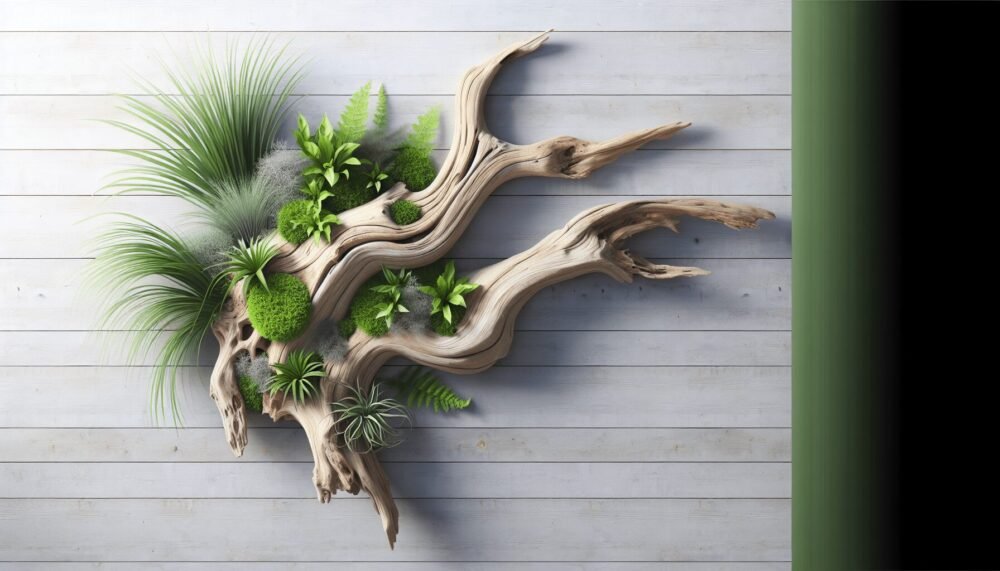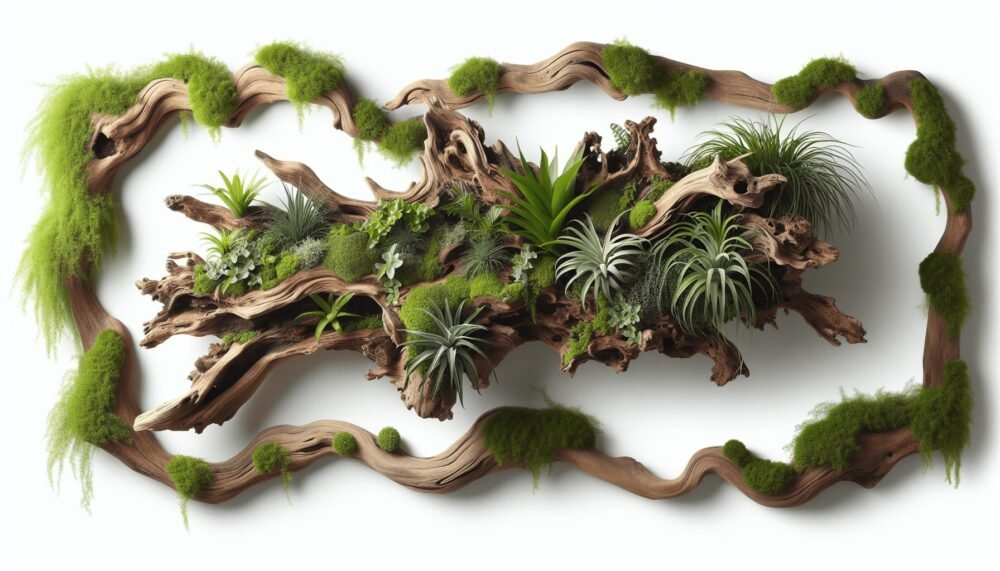Driftwood Wall Art With Plants” invites you into a creative journey where nature meets rustic charm. Imagine adorning your walls with beautiful pieces of driftwood, each uniquely shaped and weathered by the elements. You carefully arrange succulents and air plants, adding vibrant greens that bring life and freshness to the natural wood. This delightful blend creates an organic, yet sophisticated, wall art that not only enhances your living space but also reflects your love for nature and sustainable decor. Get ready to transform any room into a serene haven with this simple and beautiful DIY project. Have you ever thought about bringing a touch of nature into your home with something unique and timeless? If so, then driftwood wall art with plants might be just what you need. Imagine combining the rustic charm of driftwood with the fresh beauty of live plants. It’s like having a piece of nature’s art right on your wall.

Driftwood: Nature’s Art
What Is Driftwood?
Driftwood refers to wood that has been washed onto the shore by the action of winds, tides, or waves. Over time, this wood is smoothed and shaped by the elements, creating unique pieces with individual characteristics. No two pieces of driftwood are ever identical, making each sculpture one-of-a-kind.
Why Choose Driftwood?
Driftwood brings a rustic, organic element into any decor. It has a natural, weathered look that adds character and a sense of history to your home. Additionally, it’s an eco-friendly option; by using driftwood, you’re recycling and giving a new purpose to what might otherwise be considered waste.
Plants: A Breath of Fresh Air
Benefits of Indoor Plants
Plants offer numerous benefits when integrated into your home. They purify the air, reduce stress, and enhance the overall aesthetics of any space. Adding plants to your driftwood wall art creates a living piece that changes and grows, adding a dynamic element to your decor.
Best Plants for Driftwood Art
Not all plants will thrive on driftwood art, but many are perfectly suited for this type of display. Consider the following:
| Plant Type | Description |
|---|---|
| Succulents | Low-maintenance and drought-tolerant, great for indoor displays. |
| Air Plants (Tillandsia) | Require no soil, easy to mount directly on driftwood. |
| Mosses | Add a lush, green appearance and are easy to grow. |
| Ferns | Provide a delicate, leafy green touch. |
Combining Driftwood and Plants
Choosing Your Driftwood
When selecting driftwood, consider its size, shape, and texture. Look for pieces that have interesting shapes and natural niches where plants can be easily attached or fitted. The driftwood should be sturdy enough to support your plants and any additional hardware needed for mounting.
Prepping the Driftwood
Before you start arranging your plants, it’s essential to prep the driftwood. Start by cleaning it thoroughly to remove any sand, salt, or debris. Soaking the driftwood in freshwater for a few days can help remove any remaining salt. Once clean, let it dry completely.
Attaching the Plants
Attaching plants to driftwood can be done in several ways, depending on the type of plant.
- For air plants, you can use a non-toxic glue or fishing line.
- For succulents, secure them using inconspicuous wires or specially designed plant clips.
- For mosses and ferns, you can use moisture-retaining materials like sphagnum moss as a base and tie them with fishing line or plant wire.
Design Ideas
Minimalist Approach
If you prefer a minimalist look, consider using a single stalk of an air plant or a small cluster of succulents. This approach highlights the natural beauty of the driftwood while adding just a touch of greenery.
Lush and Green
For a more vibrant display, create a lush arrangement with multiple types of plants. Combine different textures and shades of green to create a visually appealing and varied piece.
Seasonal Themes
You can also theme your driftwood art according to the seasons. Use blooming succulents in the spring and summer, and perhaps opt for mosses or ferns in the fall and winter.

Mounting and Displaying
Choosing the Right Location
The location you choose will affect both the driftwood and the plants. Look for a spot that gets plenty of indirect sunlight. Avoid direct sunlight, which can be too harsh for many plants and can fade the driftwood over time.
Installing Securely
Driftwood wall art should be securely mounted to ensure it can hold the weight of both the driftwood and the plants. Use sturdy hooks, brackets, or wall anchors that are appropriate for the weight of your piece.
Maintenance
Maintaining your driftwood wall art with plants involves regular watering and occasional pruning. The watering frequency will depend on the type of plants you’ve chosen. Mist air plants regularly, and water succulents sparingly.
DIY Driftwood Wall Art Project
Materials You’ll Need
Here is a list of basic materials you may need for a DIY project:
| Materials | Purpose |
|---|---|
| Driftwood | Base material for the art piece. |
| Plants (Succulents, Air Plants, Mosses) | Living elements for the art. |
| Non-toxic Glue | To attach plants. |
| Fishing Line | For securing plants or additional driftwood pieces. |
| Plant Wires/Clips | To secure heavier plants or those requiring more support. |
| Wall Hooks/Brackets | For mounting the driftwood art on the wall. |
Step-by-Step Guide
- Select Your Driftwood: Find a piece that suits your style and space requirements.
- Clean and Prep: Clean the driftwood thoroughly and let it dry.
- Plan Your Design: Arrange your plants and other elements on the driftwood before attaching them.
- Attach Plants: Use glue, wires, or fishing line to secure the plants to the driftwood.
- Mount on Wall: Use appropriate hooks or brackets to securely mount your driftwood art on the wall.
- Care and Maintenance: Regularly water and inspect the plants to ensure they remain healthy and vibrant.
Inspiration and Personal Touch
Handmade Variations
Creating driftwood wall art is as much about creativity as it is about craftsmanship. Everyone’s art piece will be unique, reflecting personal tastes and styles. You might want to incorporate small decorative elements such as stones, shells, or even small trinkets that hold sentimental value.
Professional Pieces
If DIY isn’t your style, consider purchasing from artists who specialize in driftwood and plant art. Many artisans sell unique, ready-made driftwood art that can be customized to match your home decor.
Community Workshops
Look for local workshops that teach you how to create driftwood art. These community gatherings are a fun way to learn new skills and meet people with similar interests.
Environmental Considerations
Responsible Sourcing
Always ensure you are collecting driftwood responsibly. Some areas may have regulations or restrictions on collecting natural materials. Choose sources that don’t harm the environment, and avoid over-collecting from any one location.
Sustainable Practices
Use organic materials and non-toxic glues to maintain an eco-friendly approach. Recycle and reuse whenever possible to minimize waste.
Conclusion
Driftwood wall art with plants is more than just a decor trend; it’s a way to bring the beauty and tranquility of nature into your home. Whether you decide to make your own or buy a professionally crafted piece, you’re adding something unique and vibrant to your living space. It’s a functional, beautiful, and environmentally conscious way to enhance your home’s style.
So, why wait? Dive into the world of driftwood and plants, and create your very own piece of nature-inspired art. You’ll cherish the serene beauty and natural elegance it brings to your home.